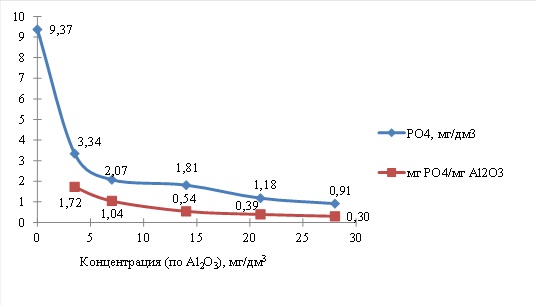Evaluation of the effectiveness of dephosphotation of wastewater from district wastewater treatment plants using aluminum polyoxychloride
DOI:
https://doi.org/10.24852/2411-7374.2022.2.68.73Keywords:
wastewater, phosphates, aluminum polyoxychloride, dephosphotationAbstract
During the survey of the existing district treatment facilities, the average characteristics of wastewater were determined at successive stages of treatment. The advantages and disadvantages of introducing coagulants for the purpose of dephosphotation of wastewater at different points of the technological scheme are considered. According to the results of the examination, the point of application of the coagulant was determined, which ensures the maximum effect of dephosphotation when using the minimum effective dose of the coagulant. The effect of different doses of aluminum polyoxychloride was studied in laboratory conditions (3.5, 7, 14, 21, 28 mg/dm3 in terms of Al2O3) on the residual content and efficiency of phosphate binding in wastewater after secondary settling tanks. The efficiency of interaction and the efficiency of phosphate removal from wastewater depending on the dose of coagulant were determined. The role of filtration through zeolite in the removal of phosphates from wastewater treated with different doses of aluminum polyoxychloride has been determined. The optimal effective concentration of the coagulant was 7 mg/dm3 (according to Al2O3) with a phosphate binding efficiency of 1.07 mgPO4/mgAl2O3. The experimental and industrial tests carried out confirmed the objectivity of the results obtained in the laboratory. With continuous management of the dephosphotation process and a coagulant dose of 7 mg/dm3 (according to Al2O3), the phosphate binding efficiency was 1.19 mgPO4/mgAl2O3, the residual phosphorus content of phosphates in wastewater after tertiary sedimentation tanks was at the level of 0.14 mg/dm3, the aluminum content did not exceed 1.1 MPC for fisheries reservoirs.
References
Alekseev M.I., Fokicheva E.A. Analiz protekaniya processov defosfotacii stochnyh vod pri ispol´zovanii mineral´nyh reagentov [Analysis of the flow of wastewater dephosphotation processes using mineral reagents] // Vestnik grazhdanskih inzhenerov [Bulletin of civil engineers]. 2014. №3. P. 168‒174.
Gadyeva A.A., Sirotkin A.S., Kirilina T.V., Burnasheva I.R. Ocenka vozmozhnosti primeneniya koagulyanta dlya defosfotacii stochnyh vod po ego toksichnosti v razlichnyh dozirovkah [Assessment of the possibility of using a coagulant for dephosphotation of wastewater by its toxicity in various dosages] // Vestnik tehnologicheskogo universiteta [Bulletin of the Technological University]. 2016. Vol. 19, №16. P. 9‒10.
Gorbachova T.T., Majorov D.V. Skorost´ hlop´eosazhdeniya v osvetlyonnyh kommunal´nyh stokah pri reagentnom udalenii fosfora [The rate of flocculation in clarified municipal wastewater during the reagent removal of phosphorus] // Vestnik sovremennyh issledovanij [Bulletin of modern research]. 2018. №12.15. P. 83‒87.
Kinebas A.K., Nefyodova E.D., Gvozdev V.A., Rusanova L.P. Effektivnost´ ispol´zovaniya polioxihloridov allyuminiya pri ochistke prirodnyh vod [The effectiveness of the use of aluminum polyoxychlorides in the purification of natural waters] // Vodosnabzhenie I sanitarnaya tehnika [Water supply and sanitary equipment]. 2013. №9. P. 52‒56.
Lukanin A.V., Spicyn K.O. Snizhenie koncentracii fosfatov v stochnyh vodah predpriyatij myasopererabatyvayushchej promyshlennosti. [Reducing the concentration of phosphates in the wastewater of meat processing enterprises] // Ekologicheskij vestnik Rossii [Ecological bulletin of Russia]. 2019. №6. P. 64‒69.
Petrov A.M., Knyazev I.V. Innovacii v biologicheskoj ochistke stochnyh vod v Respublike Tatarstan [Innovations in biological wastewater treatment in the Republic of Tatarstan] // Rossijskij zhurnal prikladnoj ekologii [Russian journal of applied ecology]. 2018. №4. P. 62‒66.
PND F 14.1:2:3.100‒97. Metodika izmereniy khimicheskogo potrebleniya kisloroda v probakh prirodnykh i stochnykh vod titrimetricheskim metodom [Method of measuring chemical oxygen consumption in natural and wastewater samples by titrimetric method].
PND F 14.1:2:4.254‒2009. Metodika vypolneniya izmereniy biokhimicheskogo potrebleniya kisloroda posle n-dney inkubatsii (BPKpoln) v poverkhnostnykh presnykh. podzemnykh (gruntovykh). pityevykh. stochnykh i ochishchennykh stochnykh vodakh [Method of measuring biochemical oxygen consumption after n-days of incubation (BPKpol) in surface fresh, underground (ground), drinking, sewage and treated wastewater].
PND F 14.1:2:4.254‒2009. Metodika izmereniy massovykh kontsentratsiy vzveshennykh i prokalennykh vzveshennykh veshchestv v probakh pityevykh. prirodnykh i stochnykh vod gravimetricheskim metodom [Method for measuring mass concentrations of suspended and calcined suspended solids in samples of drinking, natural and waste waters by the gravimetric method].
PND F 14.1:2:4.276‒2013. Metodika izmereniy massovoy kontsentratsii ammiaka i ammoniy-ionov v pityevykh. prirodnykh i stochnykh vodakh fotometricheskim metodom s reaktivom Nesslera [Method of measuring the mass concentration of ammonia and ammonium ions in drinking, natural and wastewater by photometric method with Nessler reagent].
PND F 14.1:2:4.112‒97. Metodika izmereniy massovoy kontsentratsii fosfat?ionov v pityevykh. poverkhnostnykh i stochnykh vodakh fotometricheskim metodom s molibdatom ammoniya [Method of measuring the mass concentration of phosphate ions in drinking, surface and wastewater by photometric method with ammonium molybdate].
PND F 14.1:2:4.166‒2000. Kolichestvennyj himicheskij analiz vod. Metodika vypolneniya izmerenij massovoj koncentracii alyuminiya v probah prirodnyh, ochishchennyh stochnyh I pit´evyh vod fotometricheskim metodom s alyuminonom [Quantitative chemical analysis of waters. Method of measuring the mass concentration of aluminum in samples of natural, treated wastewater and drinking water by photometric method with aluminone].
Prikaz Ministerstva sel´skogo hozyajstva RF ot 13.12.2016 №552 «Ob utverzhdenii normativov kachestva vody vodnyh ob´ektov rybohozyajstvennogo znacheniya, v tom chisle normativov predel´no dopustimyh koncentracij vrednyh veshchestv v vodah vodnyh ob´ektov rybohozyajstvennogo znacheniya» [Order of the Ministry of Agriculture of the Russian Federation № 552 dated 13.12.2016 «On approval of water quality standards for water bodies of fishery significance, including standards for maximum permissible concentrations of harmful substances in the waters of water bodies of fishery significance»].
Char´kin S.V. Organizaciya processov udaleniya fosfora iz stochnyh vod [Organization of phosphorus removal processes from wastewater] // Vodoochistka. Vodopodgotovka. Vodosnabzhenie [Water treatment. Water treatment. Water supply equipment]. 2013. №11. P. 46‒52.

Downloads
Published
How to Cite
Issue
Section
License

This work is licensed under a Creative Commons Attribution-NonCommercial 4.0 International License.




